NIHI Sumba on the island of Sumba, Indonesia, describes itself as, ‘Not an escape from everyday life. The return to a life well lived.” Sarah Siese visited recently and found it hard to leave.

Horses on beach, Sumba
While not a particularly bookish child, The Swiss Family Robinson, was quite an influence on me. I’ve long since lost the book but can recollect the touch of its fraying leather spine and dusty whiff of its pages. Aged eight, the tale captured my imagination and became my go-to story. I wanted to read it again and again.
First published in 1812, it’s about a Swiss family who get shipwrecked somewhere in the East Indies. All is lost. But the family get ashore, somewhere in the archipelago, build a brilliant shelter, and have a decade of wonderful adventures, before being rescued.
NIHI Sumba, on the comparatively untouched island of Sumba in Indonesia, 700 miles southeast of Bali, instantly reconjures the essence of those vicarious childhood adventures.
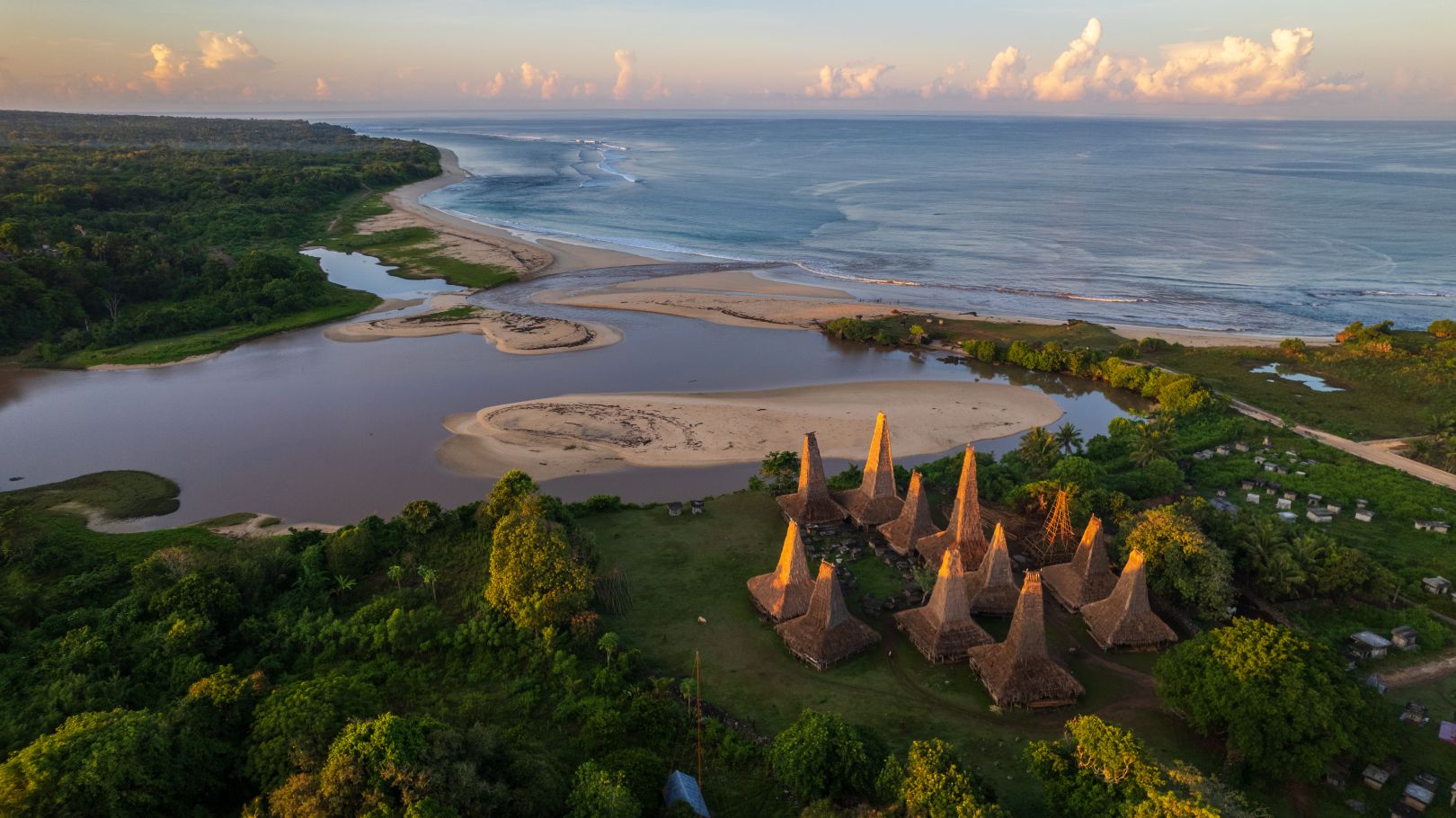
Traditional village, Sumba
NIHI Sumba sits on the edge of wildness
We’re visiting at full moon when the low tides have receded sufficiently to expose the entire reef, revealing dozens of tiny pools filled with crabby treasures. The two and a half kilometre picture-perfect beach is punctuated with giant rock formations, considered by locals to be holy Marapu relics.
Strolling the shore before any children are up, I chance upon three local women foraging through the ocean floor in search of seaweed, starfish, sea urchins, crabs, tiny fish, and octopus to use in their traditional cooking. Locals are exceptionally friendly, with one foot still living with the rituals of their ancestral Marapu religion and humble tribal culture.
The Sumbanese believe that, long before mankind existed, the Marapu (gods) descended to Earth on a celestial ship, landing on the beach where NIHI Sumba sits today. They brought Betel nut, and lime paste with them but forgot their mortar stone, so improvised by using the beach boulders, which over time, became pounded into a cylindrical tube. The gods called it Nihi (mortar) Watu (stone).
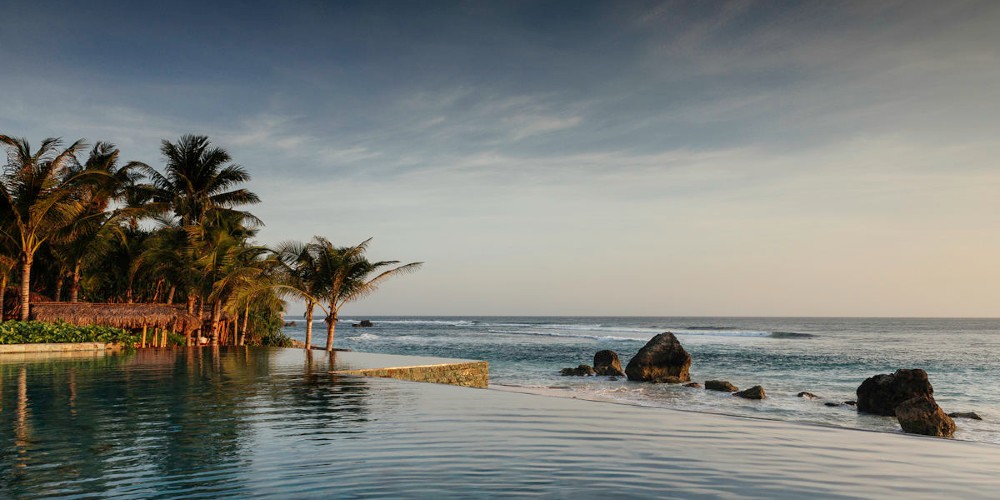
Nihiwatu Bay, Sumba Island, Indonesia
Nihiwatu Bay is a surfer’s paradise or teenage heaven
Nihiwatu Bay is a surfers’ paradise. The swell has created a left-hand break, attracting surfers from across the globe who come to ride a wave known as Occy’s Left or Big Blue. Its popularity has been central to NIHI’s story, and success, as the sheer reward of catching an epic 300 metre ride is as thrilling as it gets. It’s a teenager’s heaven.
If riding big waves holds no appeal, Rua, a 15 minute jeep ride from the resort is home to one of the calmest bays in the area: a safe environment for beginner snorkelling or surfing adventures. Children can develop skills and confidence on these bunny-slope sized waves, especially during the classic surf months between May and September.
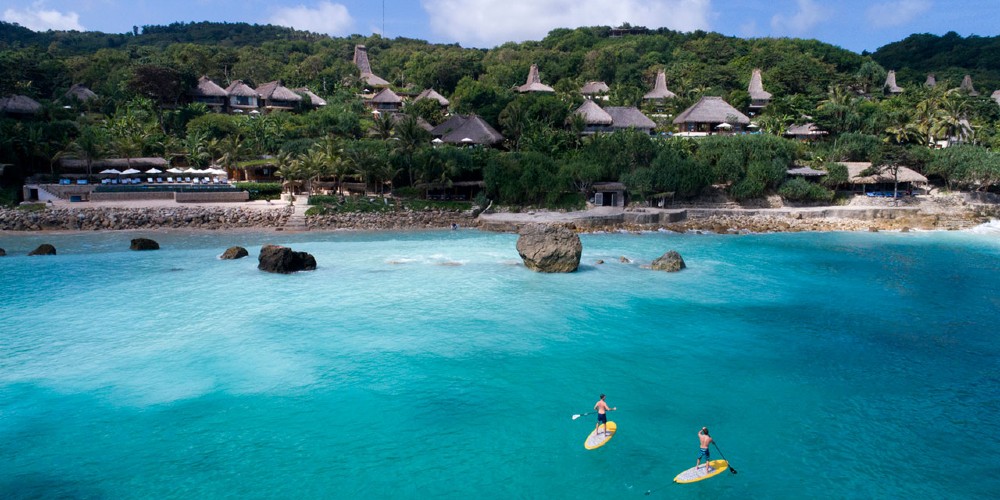
Paddleboarding, NIHI Sumba, Indonesia
NIHI Sumba unlocks our spirit of adventure
By day three we realise that Sumba is an exotic playground that unlocks curiosity and adventure for all ages. Our days are unscripted; spent exploring the turquoise waters of Nihiwatu bay, and the traditional villages nestled on the highlands of Lamboya. There is no shortage of wonderment in the adjacent landscapes.
One morning we trek to Lapopu waterfall, an easy walk accessible for multi-generations. The 40-minute scenic drive to the base of Lapopu passes beautiful paddy terraces of Wanukaka valley. A relaxed 10-minute hike along the ravine leads to a chain of rickety bamboo bridges, arriving at the foot of the thunderous waterfall cascading over moss-covered rocks for over 100 meters. It splashes and collects in a natural pool creating a spectacular spot for swimming and sunbathing on the rocks. Everyone jumps in.
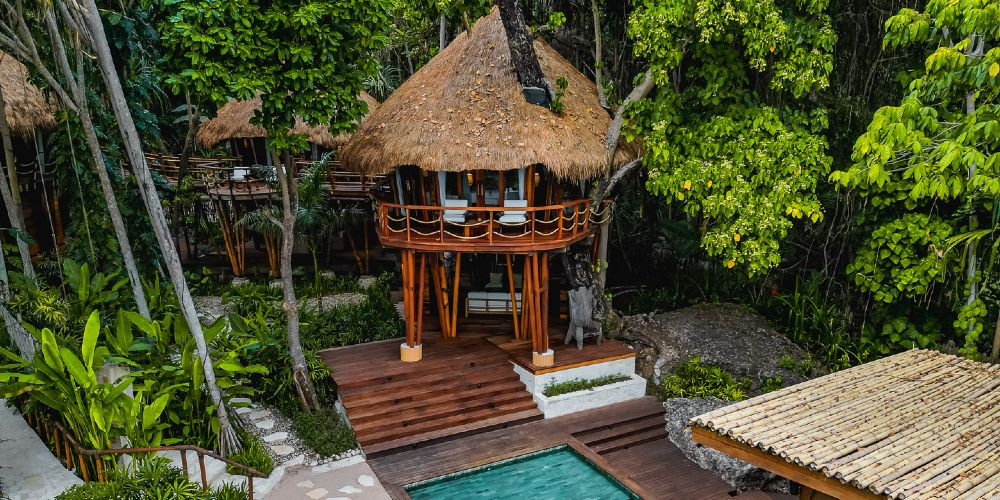
Guest villa with pool, NIHI Sumba
The NIHI Sumba estate is vast, but mainly untouched
The NIHI Sumba estate is vast – consisting of 567 acres, of which only 65 will ever be developed. Most of the 400-strong staff live in the surrounding communities. Empowering the welfare and advancement of local people is the bedrock of the foundation set up by NIHI’s owners, American financier Christopher Burch, and his friend, South African-born hotelier, James McBride.
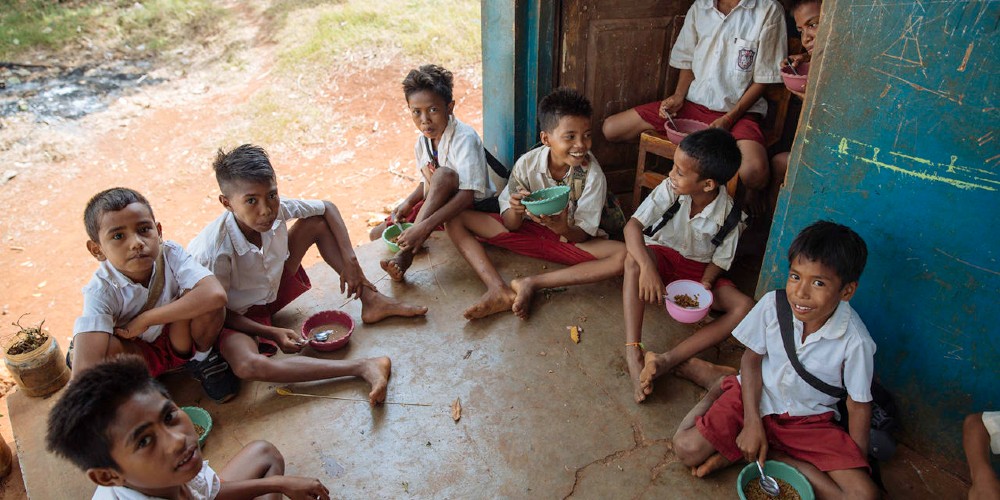
School children, Sumba Island
There’s a very close relationship between the foundation and many of the repeat guests who support various health, nourishment and education projects. It’s one thing to learn about third world aid projects in the classroom, quite another to actually visit a local water project, or volunteer with the school lunch program. Perhaps most rewarding of all is accompanying the team to a nearby school to intermingle with Sumbanese school children and contribute to English classes with songs and games. The Sumbanese are always excited for visitors and openly curious with lots of questions.
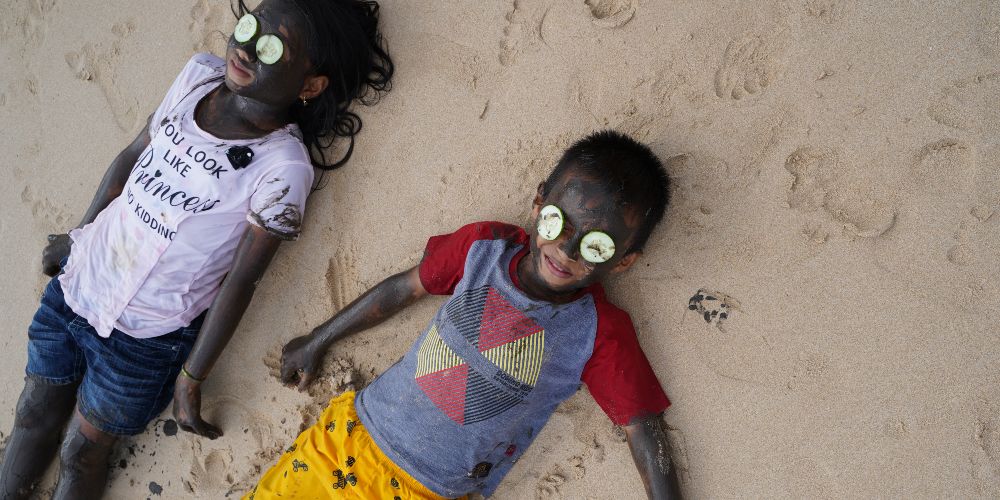
Beach facials, NIHI Sumba, Indonesia
If you want to know your future, ask a NIHI Sumba gecko
Around the resort, wide-eyed children are adept at spotting tropical island birdlife including white wing terns, cinnamon kingfishers, great-billed herons, and the sulphur-crested cockatoo. We also encountered plenty of harmless geckos. The Sumbanese believe that geckos predict the future. Ask it your question. The first chirp is ‘yes’, the next chirp is ‘no’. Continue the ‘yes’ ‘no’ pattern until the lizard finally stops chirping, then you have the answer to your question.
Larger wildlife, such as monkeys, boar, and buffalo wandering onto the beach for bath time with their farmhands are all common. And then of course, there’s the underwater world, which offers a plethora of colourful sea life directly in front of the villas.
Sea turtles have been present in the world’s oceans for over 120 millions years. Their epic journey is treacherous, with only one in every 1,000 surviving into adulthood. Human impact and changing environment threaten their existence, so it’s encouraging to know that Sumba’s waters sustain five of the seven remaining global species. NIHI’s turtle hatchery initiative rewards local communities for each egg they bring to preserve. They are safely buried on the beach. One teatime we receive a message to gather to watch dozens of hatchlings be released to the ocean. They return to the exact beach they left from;
it’s one of the world’s greatest mysteries.
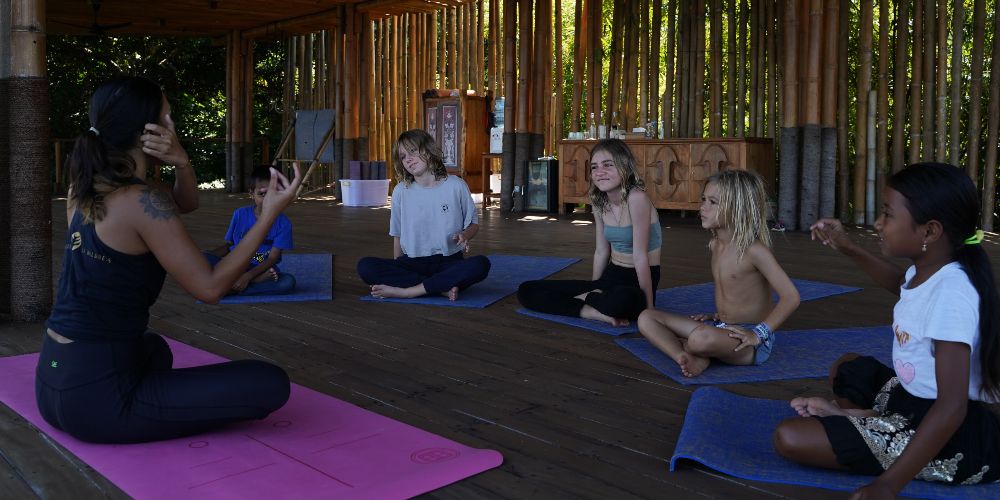
Children’s yoga class, NIHI Sumba
Successful spearfishing is an extraordinary thrill
Perhaps the most exciting ocean adventure is spearfishing with Oye, who took us out for our first lesson, which included an introduction to freediving, breath holding and familiarisation with the speargun. He made it look easy, and maybe it was just beginners luck, but we returned with our very own catch, which the chef then prepared for lunch.
Back on shore some young golfers turned the shoreline into their own private driving range with some ‘golfish’: launching biodegradable eco-friendly balls into the ocean. The coastline holds concentrations of phytoplankton nutrients, which support healthy stocks of wahoo, mahi mahi, barracuda, giant trevally, dogtooth and yellow fin tuna. Along with reef-dwelling species like job fish, grouper, jacks, and bass.
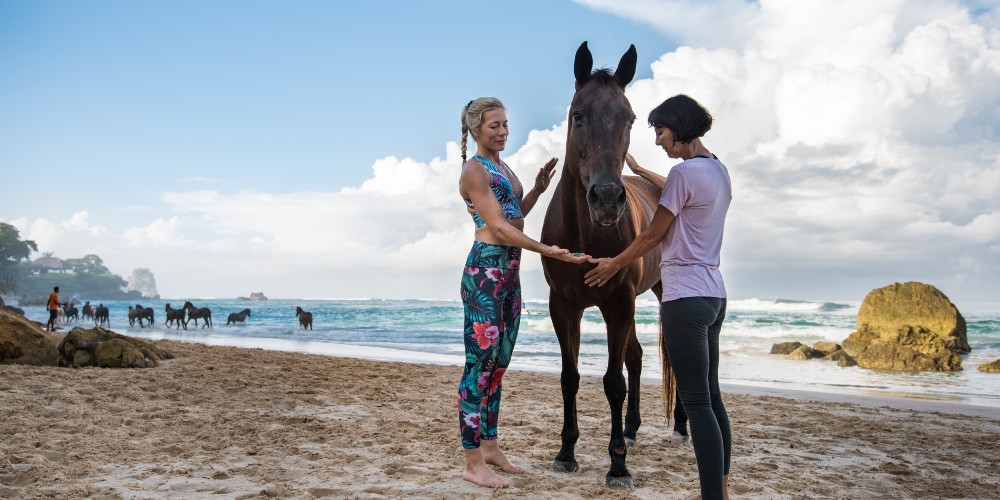
Horses are integral to the soul of NIHI Sumba
Horses are integral to the soul of NIHI Sumba
The final note though, must be to NIHI’s herd of horses as they are integral to the soul of Sumba. The original breed stems from Mongolian and Arab bloodlines, brought for trading in exchange for sandalwood and spices. Though a small breed, they are extremely agile and highly spirited. NIHI’s fabulous Kids Pony Club down at the Sandalwood Stables is where children can learn the art of horsemanship, grooming, cleaning and feeding along with pony games and handling skills. Such is their equine passion, that from March 2024, a pioneering series of equine wellbeing experiences is being launched, taking full advantage of the profound connection between humans and this special species of horse.
After a week of shipwrecked bliss, leaving is a wrench. Like the Swiss family Robinson, we were inclined to wait a decade before rescue from this blissful edge of wilderness. The kids need no convincing.
How to plan this vacation
NIHI Sumba, Lulu Amaha Saudara, 2-bedroom villa with plunge pool, from $6,000 per night (2 adults, 2 children)


